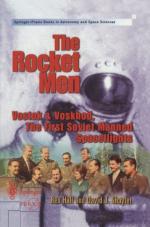|
This section contains 548 words (approx. 2 pages at 300 words per page) |

|
The Vostok ("East") program grew out of Cold War competition in the 1950s and 1960s between the United States and the Soviet Union. Vostok's engineering and scientific goals were secondary to the political aim of putting a man into space first but included testing basic spacecraft systems such as life support and demonstrating that humans could withstand launch, weight-lessness, re-entry into the atmosphere, and landing.
The 4,730-kilogram (10,428-pound) Vostok spacecraft consisted of a capsule and an instrument module. The capsule, which carried the cosmonaut, was a 2.3-meter (7.5-foot) silver sphere with a round entry hatch. A second hatch covered the parachute compartment. Four metal straps and power and control cables joined the capsule to the 2.25-meter-long (7.4 feet) instrument module, which included batteries, oxygen tanks, guidance equipment, and a retro-rocket.
Vostok reached Earth orbit on a modified R-7 missile. At the end of the mission Vostok fired its retro-rocket...
|
This section contains 548 words (approx. 2 pages at 300 words per page) |

|


